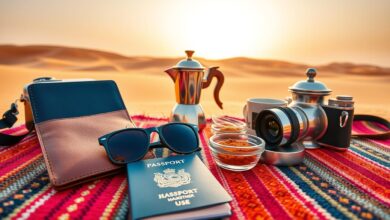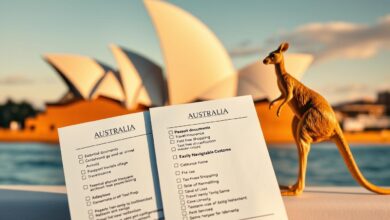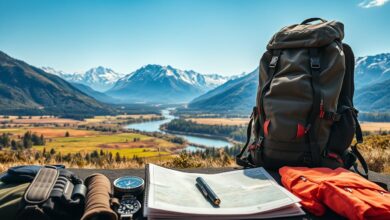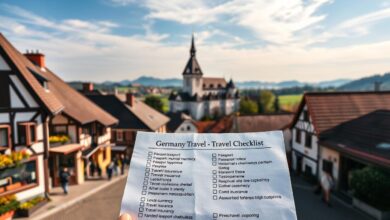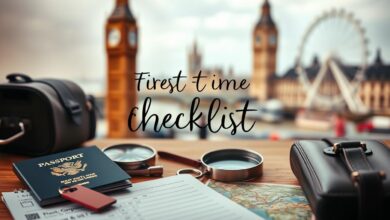Complete Canada Flight and Travel Checklist: Pre-Departure and Cultural Benefits
Planning a trip to Canada needs careful thought. A travel checklist Canada is key for any traveler.
Anúncios
It makes sure you have everything important and helps you dive into local culture.
This article shares important travel tips for Canada. It covers the must-haves for a trip to Canada. These tips will help you have a smooth and fun journey.
Understanding Travel Requirements to Canada
Traveling to Canada requires knowing a few key things to make your trip smooth. You’ll need to understand about visas, health documents, and money matters. These are important for a trouble-free visit.
Visa and Entry Regulations
Visa rules change based on where you’re from. Some people need a Visitor Visa, while others can get an Electronic Travel Authorization (eTA). The best place to find out is the Government of Canada’s official website.
Health Documentation
Health papers are now a big deal for traveling abroad. You might need to show vaccination records or COVID-19 test results. It’s smart to keep these documents handy. This is part of what you should pack for Canada to meet entry rules.
Currency and Financial Considerations
Knowing the exchange rate is key for managing your money in Canada. The Canadian dollar (CAD) is what you’ll use. Look into local banks, currency exchange kiosks, and credit cards for the best money handling. Knowing these options helps you prepare better for your trip.
Preparing Essential Travel Documents
When planning a trip to Canada, it’s key to get all your travel documents ready. This makes your journey smooth and gives you peace of mind. Here are the important things you need for your trip.
Passport Validity and Copies
First, check if your passport is valid for at least six months after you plan to leave Canada. It’s also smart to make copies of your passport. This way, you’re ready if your passport gets lost or stolen.
Travel Insurance Importance
Travel insurance is a must for Canada. It covers unexpected things like medical emergencies, trip cancellations, and lost luggage. Having insurance means you can travel without worrying too much about problems.
Accommodation Confirmations
Make sure you have your accommodation details sorted. Whether it’s a printed or digital copy, having it ready is important. It helps if your travel plans change, making it easier to check in at your accommodation.
Packing for Your Trip to Canada
Packing for Canada depends on the season and activities. A good packing list makes your trip comfortable and fun. Different seasons need different clothes, so plan accordingly.
Seasonal Clothing Guide
Canada’s weather changes a lot. In summer, wear light clothes like shorts and t-shirts. Autumn needs layers, like sweaters and jackets.
Winter is cold, so pack warm clothes, including thermal wear and waterproof boots. Spring is unpredictable, so bring both warm and light clothes and a raincoat.
Electronics and Gadgets
Right electronics make travel better. You’ll need smartphones and laptops for maps and calls. Carry universal chargers and portable power banks to stay charged.
Translation apps help with language issues. They’re handy when exploring Canada.
Travel Accessories You Shouldn’t Forget
Some accessories make travel easier. Travel pillows are great for long flights. Portable luggage scales help avoid extra fees.
Reusable water bottles keep you hydrated. A good backpack is useful for trips and carrying gear.
Arranging Transportation in Canada
Planning a trip to Canada means knowing your transportation options. You can choose from domestic flights, train and bus services, or car rentals. Each has its own benefits, fitting different travel styles and needs. Here’s a look at these options to help you plan better.
Domestic Flight Options
Domestic flights are great for covering long distances fast. Airlines like Air Canada and WestJet connect cities like Toronto, Vancouver, and Montreal. Airports vary, offering flexibility in your travel plans.
Travelers on a budget might prefer budget airlines. Booking early can also save you money.
Train and Bus Services
Train travel in Canada is known for its scenic views and comfort. VIA Rail is a top choice, offering reliable service between cities. Bus services, like Greyhound and Coach Canada, are affordable and cover the country well.
These options are perfect for those watching their budget. They also let you meet locals and experience Canadian culture.
Car Rental Tips
Renting a car gives you freedom to explore at your own pace. Agencies like National, Enterprise, and Budget are available across Canada. When renting, think about mileage, insurance, and fuel policies.
It’s important to know Canadian road signs and driving rules. Choose a car that fits the terrain, especially considering the weather.
Choosing the right transportation in Canada can make your trip better. Knowing your options helps you make smart choices, ensuring a great adventure.
Cultural Etiquette and Customs in Canada
Knowing cultural etiquette is key for anyone visiting Canada. A travel checklist should include learning about social norms. Canada’s diverse culture is shaped by its bilingual heritage, affecting how people communicate and tip.
Greetings and Communication Styles
In Canada, a firm handshake and a smile are common when meeting someone. Saying “please” and “thank you” shows politeness. In Quebec, you might hear “Bonjour” or “Bonsoir” as greetings.
Tipping Practices
Tipping in Canada is usual, ranging from 15% to 20% in restaurants. Taxi drivers and hotel staff also expect tips. Knowing these customs helps avoid awkward situations and shows respect.
Indigenous Cultures and Respect
Canada has many Indigenous peoples, including First Nations, Inuit, and Métis. It’s important to engage with their cultures with respect. Learning about their customs and visiting heritage sites is crucial.
Supporting Indigenous art and businesses is also a positive way to contribute during your trip.
Safety Tips for Travellers to Canada
Canada’s vast landscapes and lively cities are exciting to explore. But, staying safe is key to enjoying your trip. A good travel checklist for Canada should include safety tips for both city and outdoor adventures.
Emergency Numbers in Canada
It’s important to know the local emergency numbers. The main emergency number in Canada is 911. It connects you to police, fire, and medical help quickly. Other important numbers include:
- Police non-emergency: 311
- Canadian Poison Control: 1-800-268-9017
- Emergency services for the deaf and hard of hearing: Text 911
Staying Safe in Urban Areas
Urban areas have their own safety challenges. Always be careful and aware in crowded places. Use safe transportation like registered taxis or rideshare services. Don’t show off your valuables in public and choose safe neighborhoods for your stay.
Outdoor Safety Guidelines
Exploring Canada’s natural beauty requires caution. Always plan your hiking route and tell someone where you’re going. Knowing about local wildlife is crucial, especially in remote areas. Follow local camping and hiking rules for a safe and enjoyable outdoor adventure.
Understanding Weather Patterns Across Canada
Canada is huge and has many different weather patterns. Knowing these differences is key for travelers. This section talks about the unique climates, the best times to visit, and how to prepare for the weather. Understanding these helps make a trip to Canada unforgettable.
Regional Climate Differences
The weather in Canada varies a lot from one place to another. The west coast has a milder climate with warm summers and wet winters. In contrast, the interior has cold winters and hot, dry summers. The East Coast is more humid, especially in summer.
This shows why it’s important to plan your trip based on the weather. It helps you choose the best places to visit.
Best Times to Visit for Each Region
When you visit Canada, timing is everything. Summer is great for city tours and festivals. If you love winter sports, December to February is the best time to visit the Rockies.
Here’s a quick guide:
| Region | Best Time to Visit | Activities |
|---|---|---|
| British Columbia | June – September | Hiking, beaches, whale watching |
| Alberta | December – March | Skiing, snowboarding, ice skating |
| Ontario | May – October | City tours, festivals, cultural events |
| Quebec | November – April | Winter festivals, ice experiences |
| Atlantic Canada | June – October | Beach activities, seafood festivals |
Preparing for Weather Variability
Canada’s weather can change quickly. It’s smart to pack clothes that can be layered. This way, you can adjust your outfit based on the forecast.
Don’t forget to bring a light rain jacket and thermal layers. These are especially useful in mountains or by the coast. Checking the weather forecast often helps you stay comfortable and enjoy your trip.
Health and Safety Considerations
When planning a trip to Canada, health should be your top priority. It’s important to know about vaccinations, healthcare access, and staying hydrated. These factors are key to a safe and fun trip in Canada.
Vaccination Requirements
Before you go, check the latest vaccination advice. Vaccines for global health issues, like COVID-19, are crucial. Staying up-to-date with vaccines helps keep you safe and contributes to public health in Canada. For the latest info, visit official health websites.
Accessing Healthcare in Canada
You might need medical help while in Canada. Travel insurance can cover unexpected medical costs. If you need care, finding nearby hospitals or clinics is important.
Many cities have places that help tourists. Knowing where to go for healthcare before you leave can reduce stress if you need it.
Staying Hydrated and Healthy
Drinking enough water is vital for a healthy trip. Drink lots, especially when you’re outside or it’s hot. Local pharmacies can help with medications and health supplies.
Knowing your health needs is part of a good travel plan. It helps ensure a smooth and healthy trip to Canada.
Local Cuisine and Dining Options
Canada is a treasure trove of flavors, showing off its rich culture. Knowing the local food is key for travelers. Each dish tells a story of history and tradition. You’ll find amazing food experiences that are a must-try.
Must-Try Canadian Dishes
Some dishes in Canada are true cultural icons. Here are a few you should not miss:
- Poutine – A tasty mix of fries, cheese curds, and gravy from Quebec.
- Butter Tarts – Sweet pastries filled with butter, sugar, and egg, loved everywhere.
- Nanaimo Bars – A no-bake treat from British Columbia, with chocolate, custard, and a crumb base.
- Tourtière – A meat pie that’s a holiday favorite in Quebec.
Restaurant Etiquette
Knowing how to act in restaurants makes dining better. In Canada, it’s all about being polite. Here are some tips:
- Tipping 15-20% of the bill is standard for good service.
- Wait to be seated; don’t pick a table yourself.
- Respect local customs, especially in Indigenous-owned places.
Food Safety Tips
Food safety is key to enjoying Canada’s food. Here are some tips:
- Choose places with good reputations to avoid sickness.
- Be careful with street food; make sure it’s fresh and hot.
- Wash your hands before eating or use sanitizer if you can’t wash.
These tips will make your food adventures in Canada safe and memorable. Enjoy the flavors and respect local customs.
Post-Travel Checklist After Visiting Canada
After a trip to Canada, travelers need to do a post-travel checklist. This helps them document their experiences and get ready for more trips. Checking travel documents, like visas and stamps, is key. It helps for future adventures and reminds you of your journey.
Sharing your trip stories is also crucial. You can post on social media or talk to friends. Sharing your Canada experiences inspires others to travel. Using a travel checklist Canada helps organize your trip highlights.
Finally, thinking about what you learned from your trip is important. It helps improve your future travel plans. You can adjust your packing list for Canada trips. This makes you appreciate the places and cultures you visit even more.
For more information, see the official travel site:
You will be redirected to another website
FAQ
What should be included in a travel checklist for Canada?
A travel checklist for Canada should have essential items. This includes valid travel documents and clothes for the season. Don’t forget travel insurance, accommodation confirmations, and your electronics.
Also, include personal items and health documents like vaccination records. Make sure to have enough Canadian dollars.
Are there any visa requirements for traveling to Canada?
Yes, most travelers need a visa or an Electronic Travel Authorization (eTA) to enter Canada. The requirements depend on your nationality and travel purpose. Check the official Government of Canada website for the latest visa information.
How can I stay safe during my trip to Canada?
To stay safe in Canada, be aware of your surroundings. Use safe transportation and know local emergency numbers. Stay informed about the places you visit and follow safety guidelines for outdoor activities.
What seasonal clothing is recommended for a trip to Canada?
When packing for Canada, consider the season. For summer, pack lightweight clothes with layers. For winter, bring insulated jackets, thermal wear, and waterproof boots.
Always check the weather forecast for your destination to pack correctly.
What health and vaccination documentation do I need to travel to Canada?
You may need to show vaccination records, especially for COVID-19 or other required vaccines. Stay updated on Canada’s health policies before you go. This includes any testing or quarantine rules.
How can I effectively manage my currency while traveling in Canada?
Bring a mix of Canadian cash and a card with no foreign transaction fees. Use local ATMs for cash to get good exchange rates. Tell your bank about your travel plans to avoid transaction issues.
What should I know about Canadian cuisine before my visit?
Canadian cuisine is diverse and influenced by regions. Try dishes like poutine, butter tarts, and bannock. Knowing local dining customs, like tipping, will make your dining experience better.
What are the recommendations for accessing healthcare in Canada?
Carry travel insurance that covers health emergencies. Healthcare in Canada can be expensive for non-residents. Know how to find local medical facilities and have emergency contact info ready.
Published on: 15 de April de 2025


